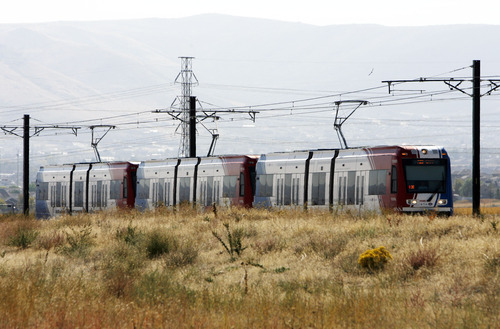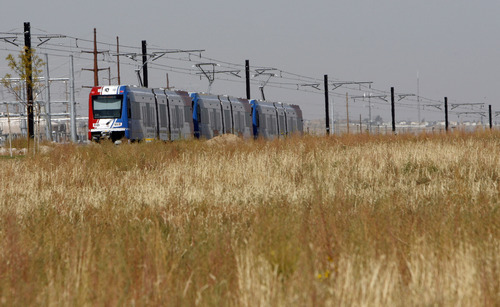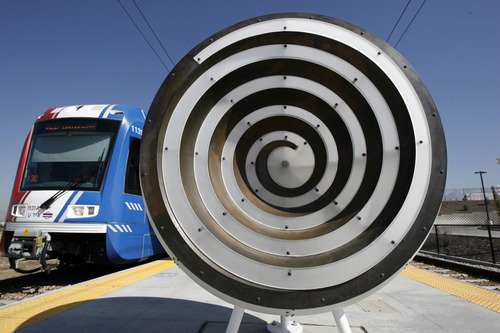This is an archived article that was published on sltrib.com in 2012, and information in the article may be outdated. It is provided only for personal research purposes and may not be reprinted.
As a person who often uses his car for work, I seldom use mass transit. I sometimes take TRAX to a Ute football game and occasionally use the system's free zone to get around downtown.
When two lines opened last year on the west side of the valley where I live, I saw the tracks and the stations, but never used them. Considering I fight a lung condition and pollution bothers me, that's not a fact I'm particularly proud of, though I rationalize it by driving a Prius.
I paid the $5.75 for an all-day pass a few weeks ago so I could ride TRAX virtually everywhere it goes, from Daybreak on the far southwest side of the valley to downtown to West Valley City to the University of Utah Hospital.
It was an interesting way to spend a day exploring the Salt Lake Valley. Without driving, it was possible to observe the world in a different way. Taking time to enjoy the view of the Wasatch Range from a train car was a surprisingly sublime experience.
Here are some observations made during a day on TRAX:
• Riders follow the rules well. I maybe saw three people drinking or eating all day. I only observed one person put his feet on a seat. The train cars were clean and surprisingly quiet. A few folks chatted, but there were many times when it seemed as if I were in a library.
• Even during the middle of the day, TRAX seems to get used. While there were only about six people on board when we left the Daybreak station — with the sounds of "I've Been Working on the Railroad" and "This Train Is Bound for Glory" on the speaker system — the cars quickly filled on each stop. It never got to the point where there was standing room only, and TRAX seemed to be busier the closer we got to Salt Lake City, but the system is being used.
• Why doesn't TRAX have WiFi? It seemed as if the vast majority of riders used some sort of electronic device.
• It's cool that the system serves the valley's major stadiums and convention centers, providing an alternative to driving for those attending events at Rice Eccles Stadium, Energy Solutions Arena, the Huntsman Center, the Maverik Center, Rio Tinto Stadium, Spring Mobile Ballpark, the Salt Palace or South Towne Expo Center.
• I only saw five transit cops all day. The three who boarded a train to actually check tickets all left when they found a man who hadn't paid. Why it took three officers to ticket one guy is beyond me.
• Why are there no restrooms at any of the stops?
• Strangest sight along the way: a llama sitting in a nearly bare West Valley City field.
• TRAX is mainly for commuters, not for shoppers. While it is possible to reach major malls such as City Creek Center, Valley Fair, Fashion Place and South Towne, some require a fairly major walk, difficult when carrying packages. And the only grocery store I observed anywhere near a station was a Smith's Marketplace on 500 South in Salt Lake City.
• To those who don't use the system, "end of the line" train boarding at the University of Utah, West Valley, Daybreak and Sandy is confusing with little in the way of explanation. I missed one Red Line train at Daybreak figuring I was sitting at the outbound tracks, only to discover the train that looked as if it were incoming was actually outgoing as well.
• The infrastructure to run this system is impressive. Forget the lines and tracks. There are two big TRAX repair shops along the way.
• Some encouraging sights included the number of trails along rivers and train tracks and the massive numbers of apartments being built next to the lines. That said, I was also surprised that there is little or no development near any of the TRAX stations. And the West Jordan parking terrace, where there is a charge to park, was virtually empty, with most commuters leaving their cars on the street to avoid paying $2 extra to park.
• Users seemed to appreciate TRAX. Two women tourists from Sacramento were delighted to use the free zone downtown so they didn't have to find parking. Zachary Myles of West Valley City told me he couldn't believe how much he saved in gas costs by taking the train to the Veterans Hospital.
As for me, I don't think I'll ever be a regular TRAX commuter. The nature of my job doesn't allow it. But my experience encouraged me to take the train more often, especially to concerts and sporting events.
Twitter: @tribtomwharton











